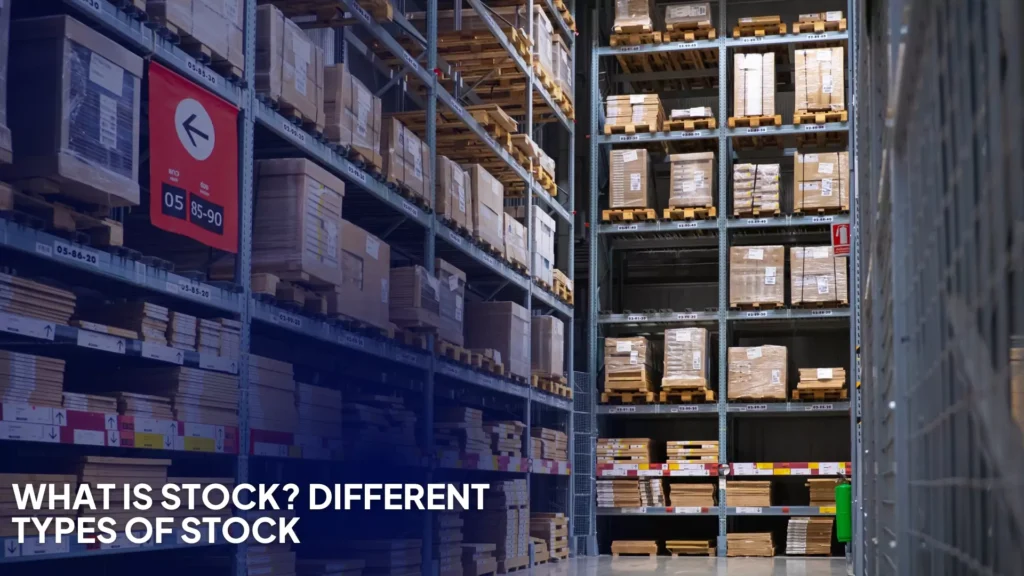The stock and supply plays a vital role in the warehousing and logistics industry. The global supply chain management market is expected to grow from $26.25 billion to $66.77 billion by 2032. Stock refers to the amount of goods that the Company holds in the warehouse, while supply refers to the amount of goods that the Company sells to the consumer at a given price and in a particular time frame. Effective management of stock and supply ensures smooth supply chain and logistics operations.
What Is Stock? Different Types Of Stock

Stock is a synonym for inventory. It refers to the goods or materials stored by the business either to meet customer demand or for production purposes. Stock can include raw materials, finished goods, or semi-finished goods. It is usually stored in warehouses and distribution centers. Stock management is quite important to optimize business operations. Overstocking of goods and products in the Fulfillment center can unnecessarily raise the warehousing costs of business. If you store perishable products, they likely to get spoiled when delayed.
Some products can expire when stored for a longer time in the warehouse. It can be a severe loss to the business. Again, out-of-stock problems can satisfy company customers. The ideal situation would be to have enough stock to meet the current demand. But in reality, such logistic solutions are impossible. However, a business owner should try to have an efficient network of suppliers who should provide goods within the shortest time.
Different Types Of Stock
1. Types Of Stock According To Their Expiration
- Non Perishable Stock – Non-perishable stock is products stored in the warehouse whose quality will not deteriorate with time. They can be stored for a longer period.
- Perishable Stock – Perishable stocks are products whose quality is damaged by external elements. These are time-sensitive products, which means they cannot be stored for a long time in warehouse storage. The stock management of perishable stocks is quite complex. Any mismanagement in the warehouse can make the stock unusable and cause loss to the business.
- Stock With Expiration Date – The products have an expiration date, and when this date passes, they cannot be sold.
2. Type Of Stock By Their Functionality
- Active Stock – The goods or products are kept in the warehouse to meet regular customer demands.
- Minimum Stock – It is the minimum amount of goods or products that the Company keeps in the warehouse, and below it, stock depletion can occur.
- Maximum Stock – It features the highest quantity of inventory that the Company decides to keep in the warehouse and above, which can cause overstocking issues. Maximum stock levels are set according to the storage space or warehouse availability.
- Stock In Transit – It refers to goods that are handed over to the shipper but have not reached their final destination. Today, most businesses use tracking systems to track goods in transit.
- Inactive Stock – The goods present in a warehouse cannot be sold anymore or reused.
- Seasonal Stock – It refers to the goods that the business specially maintains to meet the demands of a particular season or the holidays of a specific month.
- Speculative Inventory – It refers to the inventory that the Company holds in anticipation that, in the future, it will sell them at higher prices.
3. Types Of Stock By Their Operation
- Optimal Stock – It refers to the amount of stock that gives the highest profit to a business.
- Zero Stock – It refers to a condition in which business operations are conducted by holding minimal or no inventories. The goal of such businesses is to avoid problems like overstocking or out-of-stock issues.
- Physical Stock – It refers to the amount of stock present in the warehouse at any time.
- Net Stock – It is the total amount of inventory that a business has for selling purposes after accounting for various factors, such as damaged goods.
What Is Supply? Different Types Of Supply

Supply refers to the quantity of a particular product the distributor will offer customers at a specific price and for a specified period.
Factors Affecting Supply
1. Demand – An increase in product demand leads to an increase in supply, whereas a decrease in product demand leads to a reduction in supply.
2. Production Cost – Product supply will decrease with an increase in production cost and vice versa. For example, a seller will supply fewer product quantities when production costs exceed the market price.
Production costs will rise because of various factors, such as an increase in transportation and raw material costs, a rise in labor costs, and more.
3. Technology – Advances in technology can increase production, and hence, the supply of a particular product increases.
4. Natural Conditions – Climatic conditions even affect the supply of products to the market. For example, agricultural produce increases during the monsoon but decreases during drought.
5. Transport Conditions – Better road conditions can increase the product supply in the market.
6. Availability Of Resources – Raw materials, labor, and machines directly impact the production of goods. If these factors are sufficiently available and at low prices, then they will increase the product supply.
7. Government Policies – The product supply decreases with the increase in tax rates.

Different Types Of Supply
1. Market Supply – It is the total number of products that a particular business is ready to sell in the market at different prices in a specified period of time.
2. Short Term Supply – It refers to the quantity of products the seller can provide for a limited time frame. Because of this, businesses cannot expand their facilities or purchase new machinery.
3. Long-Term Supply – It refers to the quantity of goods or products the seller can provide for an extended period. Businesses can increase their supply by investing in new equipment or hiring more workers.
4. Joint Supply – In joint supply Both goods produced naturally from the same raw material or process.
5. Composite Supply – Multiple goods or services supplied to meet one single demand.
6. Elastic Supply – The producers can quickly increase or decrease the goods supplied with the price change.
7. Inelastic Supply – Producers cannot quickly change the supply amount of goods with the price change.
Difference Between Stock and Supply With Example
Differences between stock and supply listed below:
- Stock refers to the number of goods the producer has stored in its storage, warehouse and fulfillment centers. But supply refers to the total amount of goods that the producer can sell to consumers in a given period of time and at a particular price.
- Stock increases with the increase in production, but supply increases with the rise in the stock of a business.
- Stock consistently exceeds supply.
Let’s discuss with an example: An electronic store has 50 laptops of a particular Company on its first floor. These 50 laptops are in the store’s stock. The electronics store supplies 2000 units of laptops to customers every month.
Importance of Stock and Supply in Warehousing Industry

1. Stock In warehousing
When a business has stock in its warehouses, it can meet increased demands and enhance customer satisfaction.
Stock management in the warehouse is essential. The warehouses can hold goods in any amount and keep goods organized. It makes it easier to pick a particular product, pack it quickly, and deliver it to the customer’s doorstep.
2. Supply In Warehousing
Warehouses need to manage the product supply so that there is enough stock to meet customer demands and avoid problems like overstocking and out-of-stock issues.
Conclusion
Effective management of stock and supply is crucial for a business. It helps to meet customer demands without overstocking or understocking issues. The balance between supply and stock even reduces cost and increases operational efficiency.




